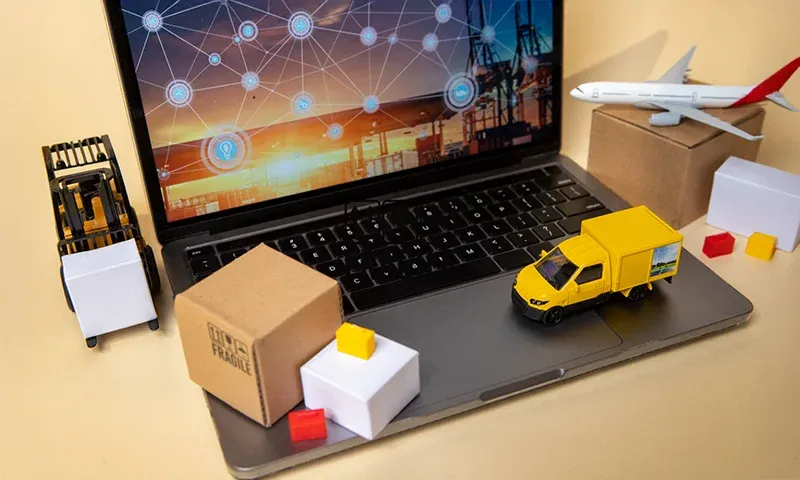The Future of Supply Chain: How Logistics Systems Are Revolutionizing E-Commerce
Shoppers are also more specific when it comes to quicker, safer, and more convenient shipping, with next-day or even same-day delivery being very common.

Shoppers are also more specific when it comes to quicker, safer, and more convenient shipping, with next-day or even same-day delivery being very common. That placed a tremendous burden on companies to re-engineer their supply chain and logistics strategy because they could not keep up.
The solution lies in the use of advanced logistics platforms —interconnected, automated, and optimized systems that track all stages of the supply chain from order fulfillment to delivery and return. They are transforming the way e-commerce businesses are run, leveraging inventory, making deliveries, and ensuring customer satisfaction.
In this blog, we’ll explore how logistics systems are revolutionizing the e-commerce supply chain, the innovations driving these changes, and what the future holds for logistics in e-commerce.
Logistics systems are simply computer programs that look after the automation and administration of the movement of the products along the supply chain. Logistics systems offer various functionality such as inventory administration, order entering, shipping, tracking, and backhaul. A good logistics system allows the companies to perform and administer all the logistics functions more efficiently and accurately.
More efficient logistics systems typically comprise:
- Real-time inventory management to control inventory levels across hundreds of warehouses and distribution centers.
- Order management to control order-to-fill, routing, shipping, and tracking for optimization.
- Route optimization for lowest cost delivery and highest speed.
- Data analysis to drive demand forecasting, supply chain efficiency optimization, and area improvement identification.
They allow companies to make better decisions, reduce operating expenses, and improve the customer experience, all of which are necessary to succeed in the hyper-speed age of e-commerce.
1. Enhanced and Speedier Delivery
One of the biggest ways that e-commerce is facilitated by logistics systems is with additional and faster delivery times. The more Prime-like, one-day or same-day shipping, businesses will have some kind of logistics plan behind it that will ensure those commitments become real. Sophisticated logistics systems will enable businesses to automate their processes and accelerate their deliveries in myriad ways:
- Route optimization :
- Distributed warehousing:
- Real-time tracking:
Since there is so much surplus delivery capacity in the case of e-commerce giants like Amazon, small companies need to have an equivalent amount of delivery capacity if they need to compete. The logistics solutions give any business of any size the ability to deliver to changing expectations.
2. Optimum Inventory Management
Proper inventory management is the essence of a successful online business. Tracking inventories across locations in real time is the secret to having stock at hand when the customer requires it without wasteful cost and excess stock.
Logistics systems enable businesses to:
- Track stock in real time: With WMS integration, logistics systems can provide real-time levels of stock in inventories, enabling businesses to prevent overstocking or stockouts.
- Automate re-ordering: Sales on the basis of past historical trends and expected future demand may be utilized in order to automate restocking of inventories' re-ordering by logistics systems when inventories dip to a critical point lower than their maxima, keeping top sellers supplied all the time.
- Inventory management across locations: As increasingly more new emerging developing e-commerce businesses burst out of warehouses and fulfillment centers located around a thousand different locations, an end-to-end complete logistics solution can track all the different locations' inventories, allocating products most efficiently and sending them out of the nearest facility to the ultimate user.
By giving more transparency of inventory availability and distribution streams, companies are able to lower waste, avoid costly stockouts, and decrease their inventory in a way that maximizes aggregate service levels.
3. Increased Order Fulfillment and Accuracy
Order fulfillment is the most important aspect of customer satisfaction, and fulfillment mistakes can result in delayed shipment, incorrect products, or bad experiences. Logistics systems automate and automate significant phases of the fulfillment process to deliver improved accuracy and speed.
The main advantages are:
- Automated order shipping: Logistics systems automatically acknowledge orders, package them up, and ship them out in an attempt to eliminate human hands from the process and speed up the shipping process.
- Batch and pick-and-pack optimization: Pick and pack functions are optimized through batching based on shipping mode or shipping requirements, minimizing warehouse time.
- Order routing: Dynamic routing of orders to the right fulfillment centers based on distance, inventory, and delivery time becomes possible with logistics software, which allows faster delivery and better warehouse space utilization.
Besides reducing costs of operations, these technologies also ensure greater customer satisfaction with orders being delivered in a timely, accurate, and lower delayed condition.
4. Green Logistics and Sustainability
As customer, corporate, and eco-friendliness needs are so trendy, there has also been an equally increasing demand for green logistics accordingly. It is the responsibility of logistics systems to make e-commerce enterprises greener and the application of carbon cheaper. Logistics systems render them green because:
- Fuel-efficient route planning:
- Green packaging:
- Consolidated deliveries:
These are the organizations that, as more and more consumers increasingly call out for progressively environmentally friendly processes and green products, will make their most significant environmental contribution, but must also optimize their brand name.
5. Better Returns Management
Returns are the part of e-commerce, but expensive and time-consuming unless computerized. Properly designed logistics allows businesses to process returns smoothly, automatically reclaim customers, and not incur the cost of doing business.
Logistics systems allow returning:
- Effective process return and labeling: Co-process-return and label-returning simultaneously, automated printing back labels, automated routing of the return, and therefore customer-friendly and hassle-free return.
- Effective return routing: The returns are sent to an area return depot or distribution center and not wasting time and money in processing the returns.
- Analysis of review of information: Trace and tracing return reason, return pattern, and return trend enable logistics platforms to study patterns which can be utilized as indicators for faults of a certain product, i.e., product description fault or quality.
Effective return management not only improves the customer experience but also saves costs and enables company to create better products.
The Future of E-Commerce Logistics
Because the future of e-commerce is transforming daily life, logistics systems have nothing but to expand even bigger. Either one or both of the trends described below are going to remake the future of e-commerce logistics:
1. AI and Automation: AI and machine learning will drive logistics systems with even better forecasting, routing optimization, and inventory management capabilities.
2. Innovations in Last-Mile Delivery: The "last mile," the final mile of delivery, is the costliest and most underpenetrated logistics real estate. Upcoming technologies like drones, autonomous delivery vans, and smart lockers will reshape the way goods are delivered to customers' doorsteps.
3. Blockchain for Transparency: Blockchain is also being utilized to create transparent and unalterable supply chains, clearer at every stage along the supply chain and with no counterfeit depth and wastefulness.
4. 5G Technology: Data exchange and real-time communication between warehouses, delivery vans, and logistics networks will be quicker, making it smoother, with 5G.
The future of logistics for e-commerce is bright, with technology being increasingly focused on efficiency, sustainability, and ease of use for the consumer.
Conclusion: Logistics Systems Facilitate E-Commerce
The strength of any flourishing e-business lies in logistics. With rising consumer demands, corporations must possess optimal logistic systems for survival and for offering increased degrees of customer satisfaction. From immediate delivery and stock control to environment-friendly operations and trouble-free reverse handling, logistic systems are redefining supply chains for e-commerce.
With IT uptake and all such efforts, business not only looks forward to today's e-commerce imperative but tomorrow's too. With better infrastructure transportation in the day, opportunities widen, cost drops, and customer enjoyment is limitless—floaters of logistics role away from back-room drudgery of a process towards being that of an e-commerce strategy multiplier.







